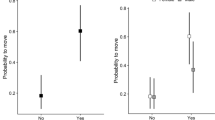Abstract
Migratory Stonechats which winter in Israel were observed in territories. Unlike most other migratory species, male and female Stonechats formed pairs in their winter territories. Pair partners, which were observed in Israel jointly reacted to intruding other Stonechats. During all times paired territorial birds and non-paired individuals occurred in the same area. Arrival and departure, body mass of birds, the proportion of unpaired birds, and duration of pair bond are described. The paired birds changed partners regularly and pairs mostly split before leaving the area in spring. Pair formation by Stonechats wintering in Israel can be regarded as a temporary association with profit for the winter.
Zusammenfassung
In Israel wurden Schwarzkehlchen einer ziehenden Population in ihrem Winterquartier beobachtet. Im Gegensatz zu den meisten anderen Zugvögeln bildeten männliche und weibliche Schwarzkehlchen Paare und verteidigten zusammen ein Territorium gegenüber Artgenossen. Neben verpaarten gab es zu allen Zeiten auch unverpaarte Individuen. Ankunft und Abzug der Vögel, Körpermassen, der Anteil an unverpaarten Vögeln und die Dauer der Verpaarung werden beschrieben. Partnerwechsel kamen regelmäßig vor und die meisten Paare lösten sich vor dem Frühjahrsheimzug auf. Die Verpaarung von Schwarzkehlchen in Israel kann als zeitlich begrenzte Partnerschaft gesehen werden, die Vorteile für den Winter bringt.
Similar content being viewed by others
Literature
Armstrong, E. A. (1956): Territory in the WrenTroglodytes troglodytes. Ibis 98: 430–437.
Brosset, A. (1971): Territorialisme et défense du territoire chez les migrateurs Paléarctiques hivernant au Gabon. Alauda 39: 127–131.
Cramp, S. (1988): Handbook of the birds of Europe, the Middle East and North Africa. Vol. 5, Oxford.
Curry-Lindahl, K. (1981): Bird migration in Africa. Vol. 2, London.
Davies, N. B. (1976): Food flocking and territorial behaviour of the Pied Wagtail (Motacilla alba yarellii Gould) in winter. J. Anim. Ecol. 45: 235–254.
Ditto &A. I. Houston (1981): Owners and satellites: the economics of territorial defence in the Pied Wagtail,Motacilla alba. J. Anim. Ecol. 50: 157–180.
Frankevoort, W., &H. Hubatsch (1966): Unsere Wiesenschmätzer. N. Brehm-Büch., Wittenberg Lutherstadt.
Freed, L. A. (1990): Mate replacement during the non-breeding months in tropical House Wrens. Acta XX Congr. Int. Orn. Christchurch/New Zealand: 1214–1219.
Glutz von Blotzheim, U., &K. M. Bauer (1988): Handbuch der Vögel Mitteleuropas. Vol. 11, Wiesbaden.
Greenberg, R. (1985): Social behavior and foraging ecology of Neotropical Migrants. Acta XVIII Congr. Int. Orn. Moscow: 648–653.
Gwinner, E., T. Rödl &H. Schwabl (1994): Pair territoriality of wintering Stonechats: behaviour, function and hormones. Behav. Ecol. Sociobiol. 34: 321–327.
Hogstad, O. (1984): Variation in numbers, territoriality and flock size of a GoldcrestRegulus regulus population in winter. Ibis 131: 403–414.
Kalela, O. (1958): Über außerbrutzeitliches Territorialverhalten bei Vögeln. Ann. Acad. Sci. Fennicae 42: 1–42.
Kelsey, M. G. (1989): A comparison of the song and territorial behaviour of a long-distance migrant, the Marsh WarblerAcrocephalus palustris, in summer and winter. Ibis 131: 403–414.
Lack, D. (1940): Pair-formation in birds. Condor 42: 269–286.
Leisler, B., G. Heine &K.-H. Siebenrock (1983): Einnischung und interspezifische Territorialität überwinternder Steinschmätzer (Oenanthe isabellina, O. oenanthe, O. pleschanka) in Kenya. J. Orn. 124: 393–413.
Mattysen, E. (1990): Nonbreeding social organisation inParus. Current Orn. 7: 209–249. N. Y.
Morse, D. H. (1989): American Warblers. Harvard, Mass.
Morton, E. S. (1980): Adaptations to seasonal changes by migrant land birds in the Panama Canal Zone. In:Keast, A. &E. S. Morton, Bird migration in the Neotropics: ecology, behavior, distribution and conservation. Washington D. C.
Ditto,J. F. Lynch, K. Young &P. Mehlkop (1987): Do male Hooded Warblers exclude females from nonbreeding territories in tropical forests?. Auk 104: 133–135.
Paz, U. (1987): The birds of Israel. Lexington, Mass.
Rappole, J. H. (1988): Intra- and intersexual competition in migratory birds during the nonbreeding season. Acta XIX Congr. Int. Orn. Ottawa: 2308–2317.
Ditto &D. W. Warner (1980): Ecological aspects of migrant bird behavior in Veracruz, Mexico. In:Keast A. &E. S. Morton, Bird migration in the Neotropics: ecology, behavior, distribution and conservation: 353–393. Washington D. C.
Salomonson, M. G., &R. P. Balda (1977): Winter territoriality of Townsend's Solitaires (Myadestes townsendi) in a Piñon Juniper-Ponderosa pine ecotone. Condor 79: 148–161.
Tramer, E. J., &T. R. Kemp (1979): Diet-correlated variation in social behavior of wintering Tennessee Warblers. Auk 96: 186–187.
Zahavi, A. (1971): The social behaviour of the White WagtailMotacilla alba alba wintering in Israel. Ibis 113: 203–211.
Author information
Authors and Affiliations
Rights and permissions
About this article
Cite this article
Rödl, T. The wintering of territorial Stonechat pairsSaxicola torquata in Israel. J Ornithol 136, 423–433 (1995). https://doi.org/10.1007/BF01651589
Issue Date:
DOI: https://doi.org/10.1007/BF01651589




